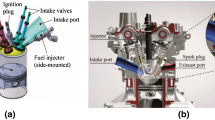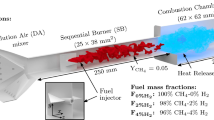Abstract
A mathematical model of gaseous fuel solenoid injector for spark ignition engine has been realized and validated through experimental data. The gas injector was studied with particular reference to the complex needle motion during the opening and closing phases, which strongly affects the amount of fuel injected. As is known, in fact, when the injector nozzle is widely open, the mass flow depends only on the fluid pressure and temperature upstream the injector: this allows one to control the injected fuel mass acting on the “injection time” (the period during which the injector solenoid is energized). This makes the correlation between the injected fuel mass and the injection time linear, except for the lower injection times, where we experimentally observed strong nonlinearities. These nonlinearities arise by the injector outflow area variation caused by the needle bounces due to impacts during the opening and closing transients [1] and may seriously compromise the mixture quality control, thus increasing both fuel consumption and pollutant emissions, above all because the S.I. catalytic conversion system has a very low efficiency for non-stoichiometric mixtures. Moreover, in recent works [2, 3] we tested the simultaneous combustion of a gaseous fuel (compressed natural gas, CNG, or liquefied petroleum gas, LPG) and gasoline in a spark ignition engine obtaining great improvement both in engine efficiency and pollutant emissions with respect to pure gasoline operation mode; this third operating mode of bi-fuel engines, called “double fuel” combustion, requires small amounts of gaseous fuel, hence forcing the injectors to work in the non-monotonic zone of the injected mass diagram, where the control on air-fuel ratio is poor. Starting from these considerations we investigated the fuel injector dynamics with the aim to improve its performance in the low injection times range. The first part of this paper deals with the realization of a mathematical model for the prediction of both the needle motion and the injected mass for choked flow condition, while the second part presents the model calibration and validation, performed by means of experimental data obtained on the engine test bed of the internal combustion engine laboratory of the University of Palermo.
Similar content being viewed by others
References
D. Dyntar and L. Guzzella, Optimal control for bouncing suppression of CNG injectors, Journal of Dynamic Systems, Measurement and Control (ASME), March, 126 (2004) 47–53.
E. Pipitone and S. Beccari, Performances improvement of a S.I. CNG bi-fuel engine by means of double-fuel injection, SAE technical paper, n. 2009-24-0058.
E. Pipitone and S. Beccari, Performances and emissions improvement of an S.I. engine fuelled by LPG/gasoline mixtures, SAE technical paper, n. 2010-01-0615.
Bosch automotive handbook, Robert Bosch GmbH (1996) ISBN 1-56091-918-3.
M. Baratta, A. E. Catania, E. Spessa, L. Herrmann and K. Roessler, Multi-dimensional modeling of direct natural-gas injection and mixture formation in a stratified-charge SI engine with centrally mounted injector, SAE International Journal of Engines, 1(1) April (2009) 607–626.
S. Di Cairano, A. Bemporad, I. V. Kolmanovsky and D. Hrovat, Model predictive control of magnetically actuated mass spring dampers for automotive applications, International Journal of Control, 80(11) (2007) 1701–1716.
P. Lino, B. Maione, C. Amorese and S. De Matthaeis, Modeling and predictive control of a new injection system for compressed natural gas engines, Proceedings of the 2006 IEEE International Conference on Control Applications, Munich, Germany, October 4–6 (2006).
J. A. Nelder and R. Mead, A simplex method for function minimization, Computer Journal, 7 (1965) 308–313.
Author information
Authors and Affiliations
Corresponding author
Additional information
Recommended by Editor Yeon June Kang
Marco Cammalleri graduated in Mechanical Engineering in 1998 at the University of Palermo. He has been assistant professor since July 2000 and teacher of mechanics of the machines since 2001 at the University of Palermo. Currently he studies about the dynamic of a S.I. engine fuel gas injector, on the rotor dynamics and mechanical vibrations and on design of mechanisms. Previously he carried out theoretical and experimental research on single and split way CVT transmissions and on rubber v-belt mechanics.
Stefano Beccari obtained his Ph.D. in Mechanical Engineering from University of Palermo (Italy) in 2005. He is currently a researcher there in the field of fluid machines. His main research interest is the spark ignition engine performance and efficiency optimization, with particular reference to the bi-fuel engines: gasoline-natural gas and gasoline-LPG.
Giuseppe Genchi graduated in mechanical engineering at University of Palermo (Italy) in 2009. Currently he is a Ph.D. student in Mechanical Engineering, in the field of fluid machines, at the University of Palermo. His main research activity is the simultaneous combustion of gaseous fuel and gasoline mixtures in spark ignition engines, with particular regards to the octane rating and supercharged engine application of the natural gas-gasoline and LPG-gasoline mixtures.
Emiliano Pipitone graduated in Mechanical Engineering in 1999 at the University of Palermo, where he has been an assistant professor in the field of Fluid Machine since March 2001. He is currently lecturer in “Machine” and in “Internal Combustion Engine” and head of the internal combustion engine laboratories of the Department. He carried out experimental and theoretical researches on internal combustion engine fuel injectors, combustion diagnosis and optimal phase control, detection and measurement of knocking phenomena, fluid dynamics of engine intake systems, engine modeling and use of gaseous fuels for spark ignition engines.
Rights and permissions
About this article
Cite this article
Cammalleri, M., Pipitone, E., Beccari, S. et al. A mathematical model for the prediction of the injected mass diagram of a S.I. engine gas injector. J Mech Sci Technol 27, 3253–3265 (2013). https://doi.org/10.1007/s12206-013-0848-6
Received:
Revised:
Accepted:
Published:
Issue Date:
DOI: https://doi.org/10.1007/s12206-013-0848-6




